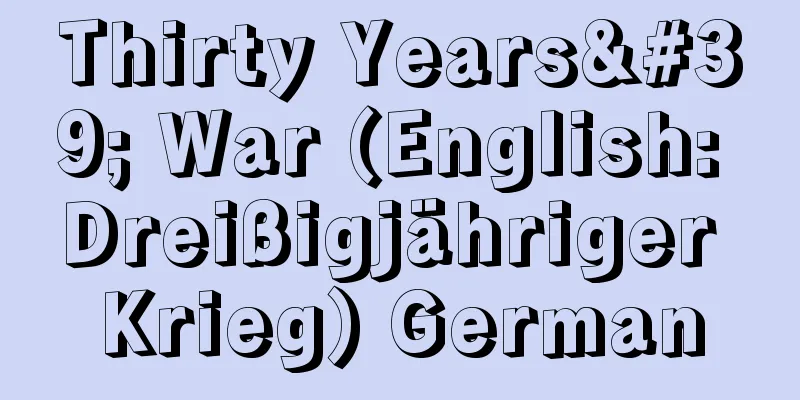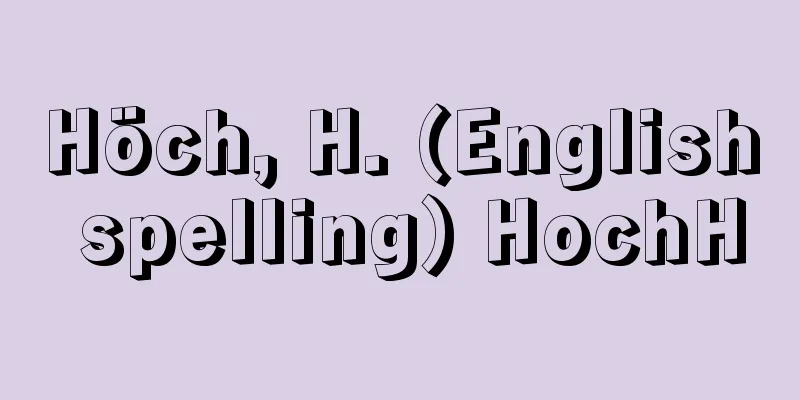Thirty Years' War (English: Dreißigjähriger Krieg) German

|
A war fought in Germany between 1618 and 1648. It is said to be the last and greatest religious war. [Kenjiro Nakamura] BeginningIn Germany, conflict between the old and new churches flared up again soon after the Peace of Augsburg, and the situation became tense in the 17th century, but war first broke out in Bohemia (Bohemia). In Bohemia, the nobles had received recognition for religious freedom from Holy Roman Emperor Rudolf II in 1609, but when Ferdinand (later Emperor Ferdinand II) ascended to the Bohemian throne in 1617, he oppressed the Protestants, causing a rebellion among the nobles. [Kenjiro Nakamura] ProgressThe course of the war can be divided into four stages depending on the country facing the Imperial faction: (1) Bohemian-Palatinate War (1618-1623) In 1619, in the midst of the civil war, when Ferdinand became emperor, the Bohemian Parliament revoked his throne and elected the Protestant Elector of the Palatinate Frederick V as king. As a result, it was inevitable that the war would spread to the whole of Germany, but because Frederick was a Calvinist, he could only get the cooperation of a few Protestant princes, while the emperor, with the cooperation of Maximilian, Duke of Bavaria, the leader of the Protestant princes, and the aid of Spain, launched a counterattack and defeated Frederick's army at Weisserberg, west of Prague, in 1620. The emperor then defeated the armies of the Protestant princes who had participated in the rebellion in various places, and the Spanish army also invaded the Palatinate. (2) Danish War (1625-1629) King Christian IV of Denmark seized this opportunity, secured aid from England and the Netherlands, and invaded northern Germany in 1625. The emperor, who found himself in a difficult position, appointed Wallenstein as commander-in-chief of the imperial army, who, in cooperation with the Bavarian commander Tille, defeated Christian and forced him to conclude the Peace of Lübeck in 1629. In the same year, the emperor issued the Edict of Restoration to oppress the Protestants, but this decree forced the Protestant princes, who had maintained neutrality up until then, to side with the anti-imperial faction, and the Catholic princes, fearing the growing power of the emperor, also pressured the emperor, who dismissed Wallenstein in 1630. (3) The Swedish Wars (1630-1635) The Swedish King Gustavus Adolphus, who was trying to expand his power in the Baltic Sea region, felt threatened by the northward advance of the imperial forces, and after obtaining assistance from France, landed in Pomerania in 1630, defeated Tille's army at Breitenfeld in 1631, and advanced into Bohemia. The emperor appointed Wallenstein as commander-in-chief of the imperial army again. Wallenstein killed Gustavus in the Battle of Lützen in 1632, but was defeated in the battle. The emperor assassinated Wallenstein in 1634 on the pretext of a peace plot, defeated the Protestant army with assistance from Spain, and forced many of the Protestant princes to sign the Peace of Prague in 1635. (4) Franco-Swedish War (1635-1648) Since the beginning of the Thirty Years' War, France had always supported the Protestants as the mastermind behind the anti-Habsburg movement, but when the Protestants lost ground, France now openly appeared on the front stage of the war and sent troops into Germany. After that, the war situation continued to fluctuate, but a mood for peace began to appear between the emperor, the German princes, and Sweden, who were tired of years of war. Peace negotiations were held after 1645, and the Treaty of Westphalia was concluded in 1648. [Kenjiro Nakamura] resultAfter the Thirty Years' War became an international war, the main rivalries were between the Austrian and Spanish Habsburgs and the French Bourbons, but it was the Eastern and Western Habsburgs who suffered the greatest blows from the war. The Treaty of Westphalia formally recognized the independence of the Netherlands and Switzerland, strengthened the independence of the German princes, and made the position of the Holy Roman Emperor merely a figurehead. In contrast to the decline of the fortunes of these two Habsburgs, France, which gained territory on the left bank of the Rhine, became the strongest country on the continent, and Sweden, which gained territory on the Baltic coast of Germany, became a powerful country in Northern Europe. [Kenjiro Nakamura] "The Thirty Years' War" by Kenjiro Nakamura (included in "World War History 5", 1966, Jinbutsu Oraisha) [References] | |Source: Shogakukan Encyclopedia Nipponica About Encyclopedia Nipponica Information | Legend |
|
1618~1648年の間、ドイツを舞台として戦われた戦争。最後で最大の宗教戦争といわれる。 [中村賢二郎] 発端ドイツでは、アウクスブルクの和議後まもなく新旧両派の対立が再燃し、17世紀に入ってからは一触即発の状況になっていたが、戦乱はまずボヘミア(ベーメン)で勃発(ぼっぱつ)した。ボヘミアでは、1609年、貴族たちが神聖ローマ皇帝ルードルフ2世から信仰の自由の承認を獲得していたが、1617年フェルディナント(後の皇帝フェルディナント2世)がボヘミア王位につくと、新教派を圧迫して、貴族たちの反乱を引き起こした。 [中村賢二郎] 経過戦争の経過は、皇帝派の対戦国に応じて次の4段階に分けられる。 (1)ボヘミア・プファルツ戦争(1618~1623) 内乱の渦中の1619年に、フェルディナントが皇帝に即位すると、ボヘミア議会はフェルディナントの王位を取り消し、新教派のプファルツ選帝侯フリードリヒ5世を国王に選んだ。そのため、戦争のドイツ全体への波及は不可避の形勢となったが、フリードリヒがカルバン派であったために、わずかの新教派諸侯の協力しか得られず、他方皇帝は、旧教派諸侯の指導者バイエルン公マクシミリアンの協力とスペインの援助を得て反攻に出、1620年フリードリヒの軍をプラハ西方のワイサーベルクに破った。続いて皇帝は、反乱に加担した新教派諸侯軍を各地に破り、スペイン軍もプファルツ領に侵入した。 (2)デンマーク戦争(1625~1629) デンマーク王クリスティアン4世は、この機会に乗じ、イギリス、オランダの援助を取り付けて、1625年北ドイツに侵入した。苦境に陥った皇帝は、ワレンシュタインを皇帝軍総司令官に任命し、ワレンシュタインはバイエルンの司令官ティリと協力してクリスティアンを破り、1629年リューベックの和約を結ばせた。同年皇帝は、回復勅令を発布して新教派に圧迫を加えたが、この法令は、それまで中立を維持していた新教派諸侯を反皇帝派の側にたたせることになり、また皇帝勢力の強大化を恐れた旧教派諸侯も、皇帝に迫って、1630年ワレンシュタインを罷免させた。 (3)スウェーデン戦争(1630~1635) バルト海域での勢力の拡張を図っていたスウェーデン王グスタフ・アドルフは、皇帝勢力の北進に脅威を感じ、フランスの援助を得たうえで1630年ポンメルンに上陸し、1631年ティリの軍をブライテンフェルトに大敗させ、ボヘミアにまで進出した。皇帝はワレンシュタインを再度、皇帝軍総司令官に起用した。ワレンシュタインは1632年リュッツェンLützenの戦いでグスタフを戦死させたが、戦いには敗れた。皇帝は和平策謀を理由に1634年ワレンシュタインを暗殺し、スペインの援助を受けて新教派軍を破り、1635年新教派諸侯の多くにプラハの和約を結ばせた。 (4)フランス・スウェーデン戦争(1635~1648) フランスは、三十年戦争の開始以来、つねに反ハプスブルクの黒幕的存在として新教派に援助を与えていたが、新教派が劣勢となると、いまや公然と戦争の表舞台に登場し、軍をドイツに入れた。その後、戦況は一進一退を続けたが、長年の戦争に倦(う)み疲れた皇帝、ドイツ諸侯、スウェーデンの間に和平の気運がみえ、1645年以後和平交渉が行われて、1648年ウェストファリア条約が成立した。 [中村賢二郎] 結果三十年戦争が国際的戦争となってから対抗関係の主軸をなしていたのは、オーストリア、スペインの両ハプスブルク家とフランスのブルボン家であったが、この戦争によって最大の打撃を被ったのは東西のハプスブルク家であった。ウェストファリア条約によってオランダとスイスの独立が正式に承認され、ドイツ国内では諸侯の独立性が強化されて、神聖ローマ皇帝の地位はいよいよ名目的存在となった。この両ハプスブルク家の衰運にひきかえ、ライン川左岸に領土を得たフランスは大陸での最強国となり、ドイツのバルト海沿岸に領土を獲得したスウェーデンも、北ヨーロッパの強国となることができた。 [中村賢二郎] 『中村賢二郎著「三十年戦争」(『世界の戦史5』所収・1966・人物往来社)』 [参照項目] | |出典 小学館 日本大百科全書(ニッポニカ)日本大百科全書(ニッポニカ)について 情報 | 凡例 |
<<: Thirty Gods - Sanjuubanjin
Recommend
Xenogryllus marmoratus (pine cricket)
A medium-sized light brown cricket (illustration)....
Sunami [town] - Sunami
Mizuho is an old town in Motosu County, in the sou...
Internet facsimile - Intarnet facsimile
...On the other hand, the Internet, a representat...
Primula farinosa (English spelling) Primulafarinosa
… [Ken Inoue]. … *Some of the terminology that me...
Koto, Go, Calligraphy and Painting - Kinkishoga
〘Noun〙 (also "kingishoga") Koto, Go, cal...
Cantabrian Sea
…the bay on the Atlantic coast that stretches fro...
Heliocentrism
…In the history of ethnology, diffusionism became...
heather
...Briar pipes are made from the roots of E. arbo...
Bethlehem
A town in the mountains 8km south of Jerusalem in ...
Ross, H.
…An American weekly magazine. Founded in 1925 by ...
Port Pirie (English spelling)
A port city in the southeast of South Australia, i...
Oura Cathedral - Oura Cathedral
A Catholic church remaining in Minamiyamate-cho, ...
Four-eyed fish - Yotsumeuo (English spelling)
A brackish-water fish belonging to the order Cypr...
Friedlander, P.
…It is synthesized from thiosalicylic acid and mo...
Crispi, Francesco
Born: October 4, 1819, Ribera, Agrigento Died Augu...









